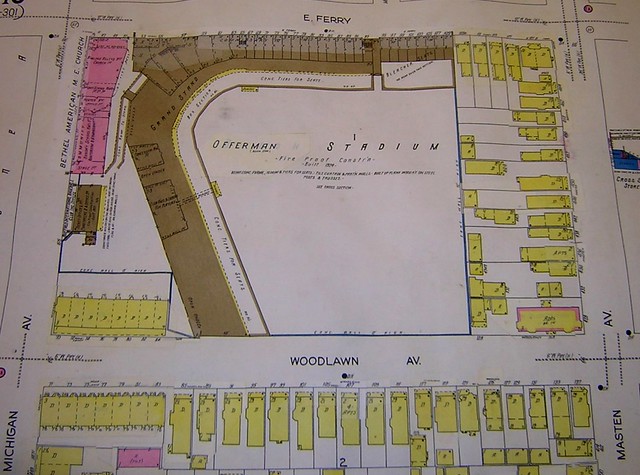While visiting Central Library recently, über librarian Cynthia Van Ness, showed me a file she had recently updated about Offerman Stadium where the Buffalo Bisons used to play to sell-out crowds of 12,000 adoring fans. I certainly didn't expect to find a reference to my own research about the neighborhood - thanks Cynthia - I did have the opportunity to read through Lawrence S. Ritter's Lost Ballparks (1992) and his chapter on Offerman Stadium. And not until I started reading Buffalo sports historian Joseph Overfield's April 19, 1975 feature length Buffalo News article, "Remember Bison Stadium" did it even occur to me to ask, "What was here before Offerman Stadium?" Reading Overfield's and Ritter's work lead me to this...another baseball park! Olympic Park was built in 1889 and was home to the Buffalo Bisons.
This image is from an 1894 map. Click image for additional information.
Olympic Park arrived on the site in horse drawn wagons from the City's rapidly developing West Side. Joseph Overfield's work includes a short piece that appeared in the Buffalo Historical Society's Niagara Frontier in 1955 describes this process. When Baseball Came to Richmond Avenue, tells the story of Buffalo baseball on the City's West Side and its connection to Olympic Park and the move to the City's near East Side.
From - When Baseball Came to Richmond Avenue by Joseph Overfield, 1955.
This image is from an 1894 map. Click image for additional information.
Olympic Park arrived on the site in horse drawn wagons from the City's rapidly developing West Side. Joseph Overfield's work includes a short piece that appeared in the Buffalo Historical Society's Niagara Frontier in 1955 describes this process. When Baseball Came to Richmond Avenue, tells the story of Buffalo baseball on the City's West Side and its connection to Olympic Park and the move to the City's near East Side.
From - When Baseball Came to Richmond Avenue by Joseph Overfield, 1955.
The grandstand was flanked on either side by open stands, while the outfield fence extended from Richmond Avenue through to Howard Street. The main entrance was at the corner of Richmond and Summer; the carriage entrance was on Howard Street. Even in those days, fans were to know the anguish of having to sit behind a post. There were 18 of them supporting the hip-style roof. Called Olympic Park, it was a modest creation when compared with the steel and concrete giants of today. Its seating capacity was just 4000 with room for a thousand or so standees and it cost about $6000...
...As an arena where athletes were to vie with bat, ball and racquet, Olympic Park was finished. However, its stands, so proudly displayed five years before, were to see further use. That fall [1888], Cassius Candee and Company sold the Buffalo franchise to Deacon White and Jack Rowe, two of the famed "Big Four" of National League days. White and Rowe leased a plot of ground at Michigan Avenue near Ferry Street the spot where the Bisons have played ever since) for a new ball park. The fences and stands of old Olympic Park were dismantled and hauled by wagon to the new location, where they were to serve for many years. Read the rest...
Related: Offerman Stadium - 1956
__________________________________________________________________________



1 comment:
Prior to Olympic Stadium, the original National League Bisons played at Riverside Park from 79-83', the sight the games very first cycle hits.
Post a Comment